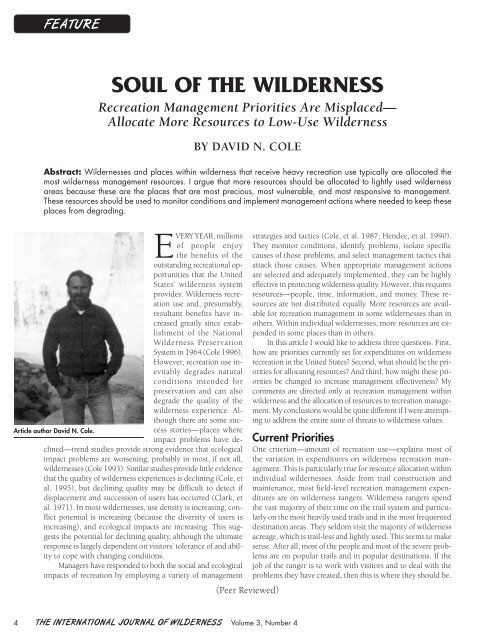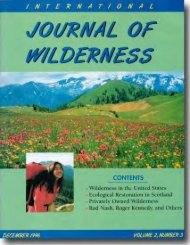Download full PDF - International Journal of Wilderness
Download full PDF - International Journal of Wilderness
Download full PDF - International Journal of Wilderness
Create successful ePaper yourself
Turn your PDF publications into a flip-book with our unique Google optimized e-Paper software.
FEATURE<br />
SOUL OF THE WILDERNESS<br />
Recreation Management Priorities Are Misplaced—<br />
Allocate More Resources to Low-Use <strong>Wilderness</strong><br />
EVERY YEAR, millions<br />
<strong>of</strong> people enjoy<br />
the benefits <strong>of</strong> the<br />
outstanding recreational opportunities<br />
that the United<br />
States’ wilderness system<br />
provides. <strong>Wilderness</strong> recreation<br />
use and, presumably,<br />
resultant benefits have increased<br />
greatly since establishment<br />
<strong>of</strong> the National<br />
<strong>Wilderness</strong> Preservation<br />
System in 1964 (Cole 1996).<br />
However, recreation use inevitably<br />
degrades natural<br />
conditions intended for<br />
preservation and can also<br />
degrade the quality <strong>of</strong> the<br />
wilderness experience. Although<br />
there are some suc-<br />
Article author David N. Cole.<br />
cess stories—places where<br />
impact problems have declined—trend<br />
studies provide strong evidence that ecological<br />
impact problems are worsening, probably in most, if not all,<br />
wildernesses (Cole 1993). Similar studies provide little evidence<br />
that the quality <strong>of</strong> wilderness experiences is declining (Cole, et<br />
al. 1995), but declining quality may be difficult to detect if<br />
displacement and succession <strong>of</strong> users has occurred (Clark, et<br />
al. 1971). In most wildernesses, use density is increasing, conflict<br />
potential is increasing (because the diversity <strong>of</strong> users is<br />
increasing), and ecological impacts are increasing. This suggests<br />
the potential for declining quality, although the ultimate<br />
response is largely dependent on visitors’ tolerance <strong>of</strong> and ability<br />
to cope with changing conditions.<br />
Managers have responded to both the social and ecological<br />
impacts <strong>of</strong> recreation by employing a variety <strong>of</strong> management<br />
BY DAVID N. COLE<br />
Abstract: <strong>Wilderness</strong>es and places within wilderness that receive heavy recreation use typically are allocated the<br />
most wilderness management resources. I argue that more resources should be allocated to lightly used wilderness<br />
areas because these are the places that are most precious, most vulnerable, and most responsive to management.<br />
These resources should be used to monitor conditions and implement management actions where needed to keep these<br />
places from degrading.<br />
(Peer Reviewed)<br />
4 THE INTERNATIONAL JOURNAL OF WILDERNESS Volume 3, Number 4<br />
strategies and tactics (Cole, et al. 1987; Hendee, et al. 1990).<br />
They monitor conditions, identify problems, isolate specific<br />
causes <strong>of</strong> those problems, and select management tactics that<br />
attack those causes. When appropriate management actions<br />
are selected and adequately implemented, they can be highly<br />
effective in protecting wilderness quality. However, this requires<br />
resources—people, time, information, and money. These resources<br />
are not distributed equally. More resources are available<br />
for recreation management in some wildernesses than in<br />
others. Within individual wildernesses, more resources are expended<br />
in some places than in others.<br />
In this article I would like to address three questions. First,<br />
how are priorities currently set for expenditures on wilderness<br />
recreation in the United States? Second, what should be the priorities<br />
for allocating resources? And third, how might these priorities<br />
be changed to increase management effectiveness? My<br />
comments are directed only at recreation management within<br />
wilderness and the allocation <strong>of</strong> resources to recreation management.<br />
My conclusions would be quite different if I were attempting<br />
to address the entire suite <strong>of</strong> threats to wilderness values.<br />
Current Priorities<br />
One criterion—amount <strong>of</strong> recreation use—explains most <strong>of</strong><br />
the variation in expenditures on wilderness recreation management.<br />
This is particularly true for resource allocation within<br />
individual wildernesses. Aside from trail construction and<br />
maintenance, most field-level recreation management expenditures<br />
are on wilderness rangers. <strong>Wilderness</strong> rangers spend<br />
the vast majority <strong>of</strong> their time on the trail system and particularly<br />
on the most heavily used trails and in the most frequented<br />
destination areas. They seldom visit the majority <strong>of</strong> wilderness<br />
acreage, which is trail-less and lightly used. This seems to make<br />
sense. After all, most <strong>of</strong> the people and most <strong>of</strong> the severe problems<br />
are on popular trails and in popular destinations. If the<br />
job <strong>of</strong> the ranger is to work with visitors and to deal with the<br />
problems they have created, then this is where they should be.










